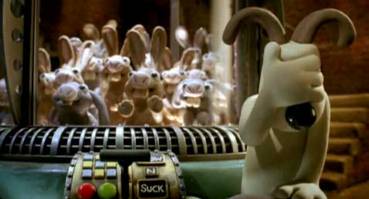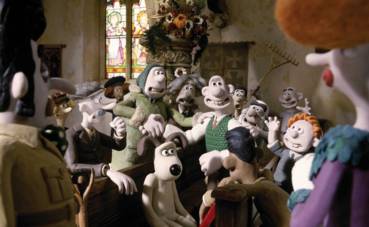"It's got to be such an inspiring idea to me, you know,
that they have to sustain me for five years..." |
Co-director, Nick Park |
Five
years. Think of that in days and making an eighty-five minute
movie over that time (that's over twenty days spent per
screen minute). Aieee. Three years of getting the script
absolutely the best it can be – time never, ever wasted
– and pre-production preparation. Two years of thirty animators
thumbing clay (or something that looks like clay but is
probably as related to plasticine as petrol is to rocket
fuel). If you are considering spending a tenth of your working
life on a single project, you'd better have a damn good
script and some major talent behind the camera. Tick, VG.
All in place.
Park
has dispelled two niggling doubts with his rather inspired Curse of the Were Rabbit. The first is:
can Wallace and Gromit sustain an eighty-five minute feature
(absolutely, yes – even though it's Gromit's movie through
and through) and secondly can anyone work with Dreamworks'
Jeffrey Katzenberg and stop their movie becoming a generic
tossed salad designed to 'homage' recent Hollywood and leave
story sense and characters to care for out of the mix? Well,
aside from a relatively painless invasion of the CG penguins
from Madagascar (a short before the feature)
there are scant clues that Katzenberg's paws have soiled
the clay. This is Nick Park. This is Aardman animation and
this is great, great fun.

In
the first Wallace and Gromit short (A Grand Day
Out) Nick Park's animation is significantly much
cruder and the story surreal to the nth degree. Just in
case there's a sentient being on the planet who hasn't seen
it, it ends with an aggressive stand up cooker robot skiing
on the moon – say what? So the 'world' of Wallace and Gromit
(almost now a single five syllable word) is established.
Man and dog live in this oddly old fashioned 50s Britain.
Wallace is an inventor with a Heath Robinson bent. His greatest
asset is his extraordinarily resourceful, mouthless mutt,
Gromit. With only his eyes and eyebrows, Gromit can communicate
a vast breadth of emotion. This is just as well as he never
opens his mouth (having no mouth to open seems to be the
principal reason). Their specific fantasy world is further
entrenched with the introduction of the penguin bank robber
in The Wrong Trousers and the demon robot
dog in A Close Shave. The film-makers take
the pair into a slightly different world in their movie.
All the animation and art direction is spot on but in order
to create the eponymous were rabbit, a bit of personality
transference has to take place (not strictly a Wallace and
Gromit 'thing' despite the former's penchant for invention).
I guess the response to my little criticism is that they
have added to W & G's world... Fair enough. That
'out of place' aspect is what stopped me cold watching the
new live action Scooby Doo – these weird supernatural creatures
were really supernatural which went against the grain of
the original Scooby-Doo adventures.
However,
this is not only a minor quibble, it's the only one. Were
Rabbit is inventive, imaginative, accessible to
all ages and above all moving in a way that clay should
not be. It is also profoundly British despite the dollar
budget Were there no British backers for what had to have
'hit' written all over it? Depressing. The set up is simple.
Wallace and Gromit are the Anti-Pesto team, the ones to
call when you want marauding pests humanely dealt with.
Their way of despatching the troublesome critters is to
capture them and then politely home them. No animal could
possibly be 'put to sleep' in Wallace and Gromit's world.
Gromit seems weary of the surfeit of rabbits until Wallace
has a brainwave via his all too inventive mind. He plans
to transfer his thoughts ("No veggies!") to the
rabbits in his care hoping that they won't go hopping away
to trouble the townsfolk all of whom are working hard to
win the Giant Vegetable competition. It's run by the local
gentry, "Call me Totty!", the second of Wallace's
romantic entanglements. If you remember, the first (in A
Close Shave) was struck down by her allergic reaction
to cheese, even Wensleydale.
So
begins the hunt for the huge and vegetably destructive 'were
rabbit'. Gromit plays Sherlock and through a very simple
but elegant clue, he finds out the identity of the marauding
beast. It's a testament to directors Nick Park and Steve
Box's skill that at exactly the moment the penny drops in
Gromit's (and my) mind, my son leaned over and said "Does
that mean that 'x' is the were rabbit?" I dough my
cap to Box and Park. That's great storytelling. It struck
me admiring Gromit's ineffably expressive eyebrows that
this is the first movie I have ever seen that hinges on
the central performance of a dog (wait, there's more), a
dog made of plasticine, a dog with no mouth and a dog with
no distinguishing features whatsoever...except for a
love of his master and a sense so common, he'd never make
it in politics. Gromit is the star of this movie and for
my money the biggest laugh out loud moment was a simple
Oliver Hardyesque look to camera and a raised eyebrow. You
have to love that dog. Hey, I laughed out loud (as did others)
in a cinema. What is to become of me?
Technically,
the film is a marvel. The miniature sets are seeped in detail
and drip atmosphere. I particularly enjoyed the lighting
(now how many movies can you say that about or would want
to single it out?) but it really is wonderfully and richly
shot. The action sequences are as accomplished as anything
coming from across the pond (and dare I say more comprehensible
given the latter are cut so fiendishly quickly now, sense
is easily sacrificed). Like Pixar, the only movie company
comparable with Aardman, the ideas have a high strike rate
and you never really know how something is going to happen
(you may know what in the sense that W & G have to end
up heroes). There's a moment when a rabbit is about to be
shot, is sucked underground but it thinks it has been shot
and is now descending to heaven. Idea for idea, it's one
of the best in a movie dense with such gems. Ironic too
that the images of the functioning 'Bun Vac' (or rabbit
suction device) were achieved by artful computer generated
plasticine bunnies. According to Park there was a staff
animator who so resisted the CG answer, he tried to animate
the thirty floating in heaven bunnies himself and nearly
killed himself with the effort... But it made my day
hearing that story.

As
far as the voice talent is concerned, I'm reminded of Ewan
MacGregor's advice to his co-star Ricky Gervais when they
performed for the CG animated Valiant.
Gervais was nervous he wasn't delivering. In the loo at
a break, MacGregor simply said "When you sound like
a complete c***, you're doing it right." Gervais was
fine after such solid advice. Well, in Were Rabbit, unless
I was told whose voices I was listening to, I wouldn't have
twigged, so far are their performances from their own voices.
Briefly stepping back into gentrified roles is Helena Bonham-Carter
as Lady Tottington. She's over the top but correctly so
but not quite as over the top as Ralph Fiennes (again, correctly
so) as the voice of the dastardly hunter Victor Quartermaine.
It's so cosy and snug a fit (unlike Quartermaine's toupée)
that the most famous voice talent of the cast often gets
overlooked. Peter Sallis is so unutterably Wallace (unutterably
in the sense that no one else could possible utter Wallace's
lines) that if he ever passes away, Wallace may well be
laid to rest with him. But Sallis is a pro and his performance
here as assured as it always was. You have to remember,
Sallis is one of the only aspects of Wallace that grounds
him, makes him likeable. He is almost always upstaged by
Gromit. Let's face it, Olivier, Brando and Pacino would
be upstaged by Gromit. Simultaneously.
As
ever, the eclectic and full music score faithfully serves
the action, the cue 'Dogfight' on the album being the stand
out action piece. This time it's Julian Nott, not Chicken
Run's Harry Gregson-Smith, who gets top baton (with
help from Harry's brother Rupert). Musically, the score
quotes many styles and in some instances (Cape Fear anyone?) it hits an homage note for note but (as in the
movie references which abound in the visuals) they do not
stop the movie in its tracks and announce to the audience
"Hey, did you spot it? You didn't? Don't worry, this
is a Katzenberg movie, there'll be another one along in
a few seconds." The references are woven in to the
fabric of the movie, stitch for stitch. That said, this
movie could only have been made by a northener (Park was
born in Preston) and someone of my age having been so entranced
with the original (and best) Thunderbirds TV show.
At
the climax of the movie, it's not a spoiler to say that
man and dog are reunited happily. It is surprising to me
that it choked me up! OK, let's examine this. One lump of
dog shaped clay jumps up into the arms of a lump of man
shaped clay... One big lump and I'm deeply moved (with
a lump of my own, location; throat)? As one of the IMDB
contributors quite rightly mentioned that for this to happen,
there is some 'seriously accomplished storytelling' at work.
Gromit, all through the movie has been mildly disapproving
of his master but we know they both care for each other
deeply. When a tear is summoned as Wallace lays, apparently
dead, (my God, I can feel echoes of the emotion behind my
eyes right now) it breaks your heart.
If
you know Wallace and Gromit, you know what you're in for.
Sit back and enjoy what, in any other hands, would be a
retro fifties comedy more in keeping with Carry
Ons than any other 'type' of British movie. But
with animation, the style is the thing and its charms fuse
with the wit and you end up with warmth and big cheesy grins.
Cracking stuff. Oh, and there was applause! Something is
definitely working if there is applause...
|